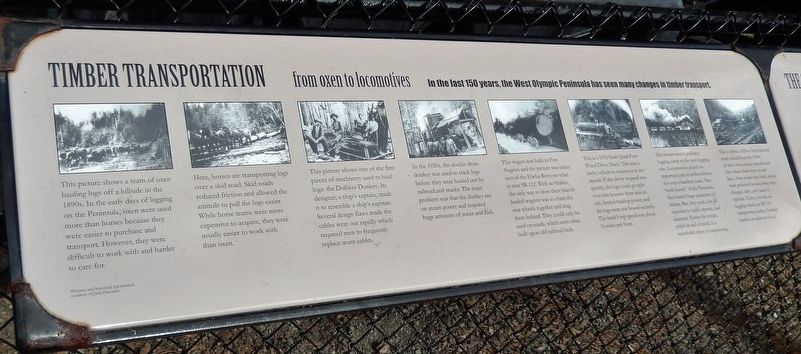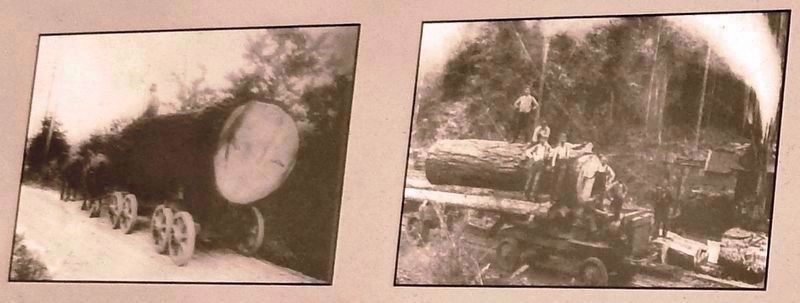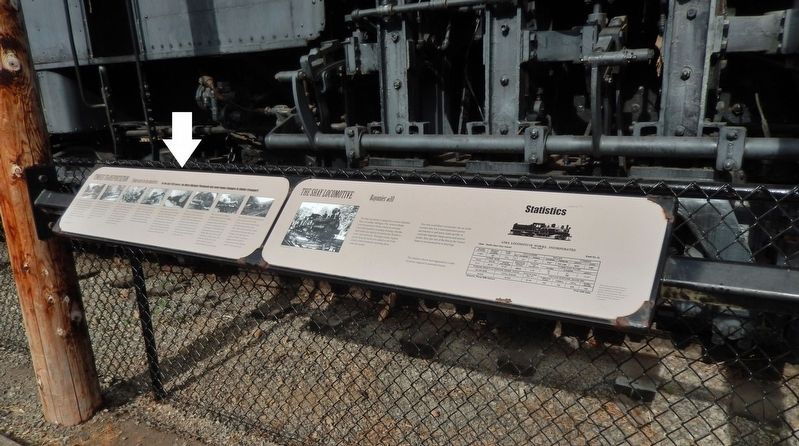Forks in Clallam County, Washington — The American West (Northwest)
Timber Transportation
From Oxen to Locomotives
In the last 150 years, the West Olympic Peninsula has seen many changes in timber transport.
photo 1:
This picture shows a team of oxen hauling logs off a hillside in the 1890s. In the early days of logging on the Peninsula, oxen were used more than horses because they were easier to purchase and transport. However, they were difficult to work with and harder to care for.
photo 2:
Here, horses are transporting logs over a skid road. Skid roads reduced friction and allowed the animals to pull the logs easier. While horse teams were more expensive to acquire, they were usually easier to work with than oxen.
photo 3:
This picture shows one of the first pieces of machinery used to haul logs: the Dolbeer Donkey. Its designer, a ship's captain, made it to resemble a ship's capstan. Several design flaws made the cables wear out rapidly which required men to frequently replace worn cables.
photo 4:
In the 1920s, the double drum donkey was used to stack logs before they were hauled out by railroad and trucks. The main problem was that the donkey ran on steam power and required huge amounts of water and fuel.
photo 5:
This wagon was built in Port Angeles and the picture was taken east of the Elwha River on what is now SR 112. With no brakes, the only way to slow these heavily loaded wagons was to chain the rear wheels together and drag them behind. They could only be used on roads, which were often built upon old railroad beds.
photo 6:
This is a 1915 Nash Quad Four Wheel Drive Truck. This was a tricky vehicle to maneuver in the woods. If the driver stopped too quickly, the logs could go right over him because there was no cab, limited braking power, and the logs were not bound securely. The truck's top speed was about 16 miles per hour.
photo 7:
This locomotive is pulling a logging camp to the next logging site. Locomotives played an important part in timber history for over a hundred years. True "work horses" of the Peninsula, they hauled huge quantities of timber. But, they took a lot of expertise to build, operate, and maintain. Notice the trestle, which in and of itself, is a remarkable piece of engineering.
photo 8:
This is either a GM or International truck reload from the 1940s. At first, these trucks carried loads only where there were no rail lines. After roads were built, trucks were preferred because they were cheaper, safer, and easier to operate. Today, you can see logging trucks on SR 101 transporting timber, finished lumber or cedar products.
Pictures and historical information
courtesy of Jack Zaccardo
Topics. This historical marker is listed in these topic lists: Horticulture & Forestry • Industry & Commerce • Railroads & Streetcars.
Location. 47° 57.261′ N, 124° 23.113′ W. Marker is in Forks, Washington, in Clallam County. Marker is on North Forks Avenue (U.S. 101) south of Tillicum Lane, on the right when traveling north. Marker is located in front of a large, covered, railroad locomotive exhibit on the west side of Tillicum Park, facing US Highway 101. Touch for map. Marker is in this post office area: Forks WA 98331, United States of America. Touch for directions.
Other nearby markers. At least 1 other marker is within walking distance of this marker. The Shay Locomotive (here, next to this marker).
More about this marker. Marker is a long, rectangular, painted metal sign, mounted horizontally, at waist-level, on the fence protecting the railroad locomotive exhibit.
Credits. This page was last revised on February 5, 2019. It was originally submitted on February 2, 2019, by Cosmos Mariner of Cape Canaveral, Florida. This page has been viewed 261 times since then and 14 times this year. Photos: 1. submitted on February 4, 2019, by Cosmos Mariner of Cape Canaveral, Florida. 2, 3, 4, 5. submitted on February 5, 2019, by Cosmos Mariner of Cape Canaveral, Florida. 6. submitted on February 4, 2019, by Cosmos Mariner of Cape Canaveral, Florida. • Andrew Ruppenstein was the editor who published this page.





